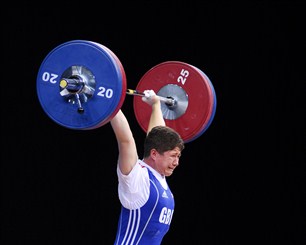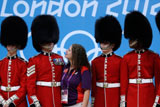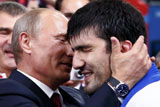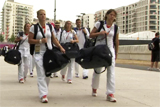Weightlifting
Updated: 2012-05-15 10:19:46
( london2012.com)
|
|||||||||||
Weightlifting will showcase a test of pure strength - the oldest and most basic form of physical competition.
The aim of Weightlifting is simple: to lift more weight than anyone else. The result is pure sporting theatre of the most dramatic kind, and a real spectator favourite.
 |
Competition dates
July 28 - Aug 7
Competition venue
ExCeL
Number of medal events
15 - eight men's and seven women's weight categories.
Number of competitors
260 (156 men and 104 women). Each country is limited to 10 athletes (six men and four women) across all events, with a maximum of two athletes in any event.
Field of play
Athletes compete on a platform, which is 4m x 4m and 10cm high.
History of Weightlifting at the Olympic Games Men's Weightlifting featured at the first modern Olympic Games in 1896, with women's Weightlifting introduced at Sydney 2000.
The heaviest individual weight lifted in Olympic competition was achieved by Hossein Rezazadeh of the Islamic Republic of Iran. At the Athens 2004 Games, Rezazadeh clean-and-jerked 263.5kg - a weight roughly equivalent to five flyweight boxers. The basics
Competitors in Weightlifting are divided into 15 weight categories, eight for men and seven for women. The strongest competitors may lift more than three times their body weight.
Each event features two types of lift. In the Snatch, the bar is lifted from the floor to above the head in one movement. By contrast, the Clean and Jerk is a two-stage action - the bar is first brought up to the shoulders before being jerked over the head.
Competition format
Each lifter is allowed three attempts at the Snatch and three attempts at the Clean and Jerk. Their best lift in each is combined to determine their overall result. If an athlete fails to make a valid lift with any of their three attempts in the snatch, they are eliminated.
When a tie occurs, the athlete with the lower bodyweight is declared the winner. If two athletes lift the same total weight and have the same bodyweight, the winner is the athlete who lifted the total weight first.
Officials
Three referees judge the success of each attempt, indicating with either a red or a white light.
Loaders are responsible for ensuring that the bar is in the right position and loaded with the correct weights. They must never touch the bar during the lift attempt.
Keys to success
While strength is obviously a key quality for a successful weightlifter, the winning lifters will also have excellent technique. A good lift must be judged successful by at least two of the three referees. In the Snatch the weight is lifted in one continuous motion and the lifter stands motionless, arms and legs extended, with feet in line. In the Clean and Jerk the lifter first lifts the weight on to his/her chest (clean), then extends the arms and legs, with feet once more in line (jerk).
Breaking the rules
As well as physically not being able to lift the weight required, the judges will penalise illegal or incorrect technique. For example, it is judged a time-out if the athlete fails to start the lift within the allocated time; and no part of the athlete other than his/her feet may touch the mat.
Jargon buster
No lift - a lift that is judged to be unsuccessful by at least two of the three referees.
Press out - an illegal move where the lifter bends the arms while holding the bar overhead, then presses them out to straighten them.
Squat - to drop while bending the legs, with the feet to either side.
Medal Count |
||||
| 1 | 46 | 29 | 29 | |
| 2 | 38 | 27 | 22 | |
| 3 | 29 | 17 | 19 | |
| 4 | 24 | 25 | 33 | |
| 5 | 13 | 8 | 7 | |
| 6 | 11 | 19 | 14 | |
















